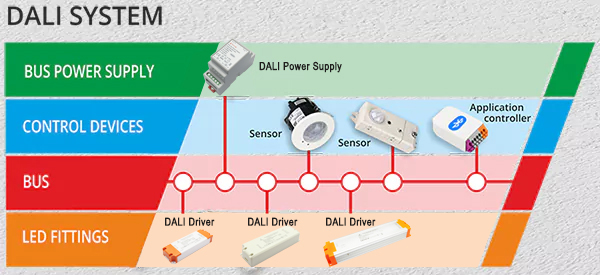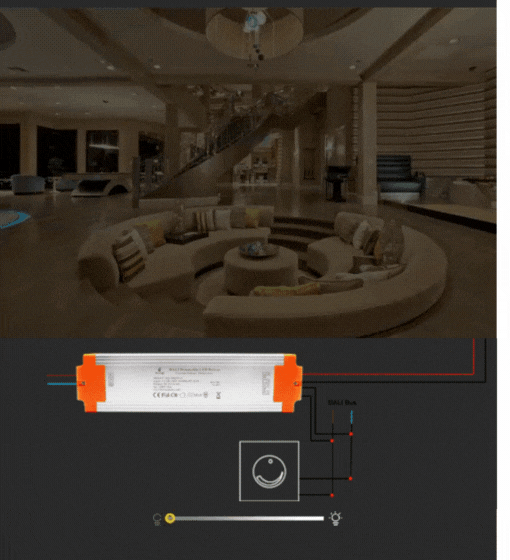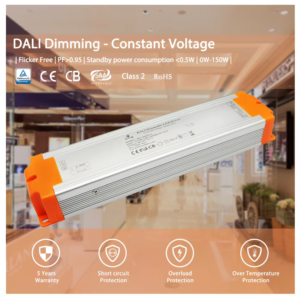In today's advanced lighting systems, precise control and flexibility are essential. DALI dimming ensures compatibility across manufacturers and provides seamless dimming. DALI is a protocol for digital communication. It is designed for lighting control devices. This article explores DALI dimming. It covers its benefits and how it stands out in lighting control. It aims to help lighting designers and homeowners understand it well. They all want to enhance their lighting systems.
DALI (Digital Addressable Lighting Interface) dimming is a standardized protocol used for lighting control, allowing precise and flexible management of lighting systems. DALI dimming drivers ensure compatibility across various manufacturers, providing a seamless and consistent dimming experience for LED lighting applications. This system is very useful in complex lighting setups. Individual control of light fixtures is necessary. It ensures that each light can be dimmed to the desired level. This helps with both energy efficiency and ambiance.
- How Well Do You Understand DALI Dimming
- How Did DALI Come About?
- How Does DALI Dimming Work?
- Where is it Commonly Used?
- When Should You Install it for Best Results?
- How is DALI System Wired?
- What Components Make Up the DALI Dimming System?
- What’s the Difference between DALI and 1-10 V?
- Are all DALI Products Compatible with Each Other?
- Should You Consider DALI Dimming?
- Advantages of DALI Dimming Control
- Disadvantages of DALI Dimming Control
- DALI as A Worthwhile Investment
- boqi: A Reliable Provider of DALI Drivers
- Conclusion
To fully understand DALI dimming, let's delve into its origins, functionality, and applications. This exploration will help clarify why DALI dimming is now a top choice in both commercial and residential lighting. It will offer insights into its technical benefits and practical uses.
How Well Do You Understand DALI Dimming
DALI dimming is a robust and reliable system for controlling lighting fixtures. It is designed to offer precise control over lighting intensity, color, and other parameters. With DALI, each light can be individually addressed and controlled, making it ideal for complex lighting setups. The system is reliable because it is digital. It performs well even in large installations. Additionally, DALI systems are flexible. They enable easy changes to lighting schemes without the need for extensive rewiring. This makes them great for dynamic environments where lighting needs may change.
- Open Standard Protocol: The DALI protocol is an open standard, which means any manufacturer can use it. Initially based on the IEC60929 standard, it has evolved over time to comply with the IEC62386 standard. This evolution ensures that all DALI components from different manufacturers can work together seamlessly, provided they feature the DALI logo.
- 2-Way form of digital communication DALI systems use digital signalsto transfer commands from the control systems to the luminaire and back. Note that a luminaire consists of the LED drivers and the LEDs. Picture this, you can talk to the LED luminaires, and they can talk back to you as well by the DALI controlled drivers.
How Did DALI Come About?
DALI was developed to address the need for a universal and interoperable lighting control system. It emerged as a team effort among major lighting manufacturers. They wanted to create a standard protocol. This protocol ensures that different products and brands work together easily. The initiative aimed to simplify lighting controls. It aimed to reduce the complexity of combining products from various makers. Over time, DALI has changed. This change brought DALI-2, which has better features and works better with other systems. It reflects the ongoing commitment to improve the protocol for modern lighting.

How Does DALI Dimming Work?
DALI dimming works by sending digital signals over a dedicated bus line. The signals control the light output of DALI-compatible fixtures. Each fixture or driver has a unique address, allowing for individual or group control. The system can handle up to 64 devices on a single bus, making it highly scalable for various applications. DALI signals are digital. They ensure accurate and reliable communication. They minimize issues like signal degradation in analog systems. Additionally, each fixture can provide feedback. This allows for real-time monitoring and adjustments. It ensures the best performance and energy efficiency.

Where is it Commonly Used?
DALI dimming is common in commercial buildings, offices, and industry. Precise lighting control is crucial there. It is also popular in homes for smart lighting. It offers features like scene setting and scheduling. In commercial environments, DALI systems enhance productivity and comfort by providing tailored lighting conditions. In homes, DALI helps make flexible living spaces. They can adapt to different activities and moods. DALI systems are adaptable and precise. They are suitable for a wide range of applications. These include large installations in public buildings and advanced home automation systems.


When Should You Install it for Best Results?
For best results, use DALI dimming in places where you need flexible and precise lighting control. This includes spaces with dynamic lighting needs. Examples are conference rooms, auditoriums, and retail stores. Early planning and integration into the building's lighting design are essential for optimal performance. Consider DALI during the initial design. This can maximize the system's capabilities and meet lighting needs efficiently. Retrofitting existing buildings with DALI can also be beneficial, providing enhanced control and energy savings compared to traditional lighting systems.
How is DALI System Wired?
A DALI system is wired using a simple two-wire bus that connects all DALI devices. The bus carries both power and data, simplifying the installation process. Each device gets a unique address. This allows for easy setup and control via a central controller or software. The simplicity of the wiring reduces the potential for errors during installation and makes it easier to expand the system as needed. DALI systems offer centralized control. They allow for full management of lighting. This includes scheduling, dimming, and scene setting. You can control all of this from a single interface.
What Components Make Up the DALI Dimming System?
The main components of a DALI dimming system include:
- DALI bus: It is a 2-wire that transfers information between the application controllers and the application receivers.
- DALI Controllers: Central units that send commands to the connected devices. These controllers can be standalone units. They can also be integrated into building management systems. They offer extensive control options.
- DALI Drivers: Devices that receive commands and adjust the lighting output accordingly. DALI drivers come in many configurations. They suit different light fixtures. This ensures they work well together.
- DALI Sensors: Devices that provide feedback and automate lighting adjustments based on occupancy or ambient light levels. The sensors make the system more efficient. They do so by ensuring that lighting is right for the current environment.
- DALI Power Supply: Provides power to the DALI bus. A reliable power supply is crucial. It keeps communication and control consistent for all DALI network devices. It requires approximately 16 V when it transmits no information and more when it transfers any information.
What’s the Difference between DALI and 1-10 V?
While both DALI and 1-10 V systems are used for dimming, they operate differently. DALI uses digital signals for precise control and feedback. It allows addressing individuals and has advanced features. 1-10 V, on the other hand, uses an analog signal to dim lighting fixtures, offering less precision and no feedback capabilities. 1-10 V systems are analog. They can have less consistent dimming, especially over longer distances. DALI's digital approach ensures each fixture gets the right signal. This results in smoother, more reliable dimming. Also, the ability to give feedback and monitor performance in real-time gives DALI a big advantage. This is true for management and maintenance.
| Items | DALI | 1- 10 V |
|---|---|---|
| Communication | Digital | Analogue |
| Control Functions | DALI offers a wide range of functions beyond normal on/off switching and simple dimming. These include emergency light testing and feedback, as well as color-changing capabilities. | It only offers the switching on/off and simple dimming functions. |
| Interoperability | The DALI dimming curve is standardized, allowing drivers from different manufacturers to be used on the same dimming channel with consistent results. | Its curve is non-standardized. Therefore when you use different brands of drivers on the same dimming channel you can end up with inconsistent diming results. |
| Addressability | DALI systems can respond to commands sent to different addresses/devices. This enables advanced features such as grouping, scene-setting, and configuring light fittings to match room layouts. | It’s not addressable. Therefore you cannot enjoy the other features. |
Are all DALI Products Compatible with Each Other?
Yes, all DALI products are designed to be compatible with each other, thanks to the standardized protocol. This ensures that devices from different makers can work together easily. It gives flexibility and ease of use. The DALI standard has strict rules for communication and performance. They ensure that all certified products meet the criteria for working together. This compatibility simplifies the design and installation process. It allows mixing and matching to pick the best parts for an application. You might be upgrading or installing a new system. The assurance of compatibility makes DALI a versatile and reliable choice.

Should You Consider DALI Dimming?
If you require a reliable, flexible, and precise lighting control system, DALI dimming is an excellent choice. It is very helpful in places with complex lighting needs. It is also useful where saving energy and automation are priorities. DALI systems offer great control over lighting. They enable custom settings for different times or activities. Optimized lighting management can save energy. It can also cut costs over time. DALI systems are suitable for projects of any size, thanks to advanced features and scalability. They meet the needs of both small and large installations.
Advantages of DALI Dimming Control
Precision allows exact control over light levels. It ensures the best lighting for any task or environment. The ability to fine-tune lighting settings contributes to both comfort and productivity.
- Flexibility: Supports individual and group control of fixtures, enabling customized lighting solutions. This flexibility is particularly valuable in multi-use spaces where lighting needs may vary.
It works with products from many manufacturers. This ensures a wide range of options for system design and use. The standardized protocol simplifies integration and ensures consistent performance.
- Scalability: Suitable for small to large installations, making it a versatile choice for any project size. The ability to expand the system as needed ensures that it can grow with changing requirements.
- Energy Efficiency: Optimizes lighting usage based on real-time data, reducing energy consumption and costs. Automated adjustments are based on occupancy and light levels. They help sustainable building practices.


Disadvantages of DALI Dimming Control
- Cost: More expensive than traditional lighting control systems. The initial investment can be higher, but the long-term benefits often justify the cost.
- Complex Installation: Requires careful planning and setup. The need for precise configuration and programming may necessitate professional installation.
- Technical Expertise: May require professional installation and configuration. Ensuring that the system is set up correctly is crucial for achieving optimal performance and reliability.
DALI as A Worthwhile Investment
It costs more upfront. But, DALI dimming offers long-term benefits. It saves energy and gives better control. And, it is adaptable. It is a worthwhile investment for projects where lighting quality and flexibility are paramount. Improving energy efficiency and cutting costs can save a lot over time. Also, DALI systems offer better control and customization. They help create more comfortable and productive environments. It is great for projects that prioritize sustainability and advanced lighting control. DALI is an excellent choice.
boqi: A Reliable Provider of DALI Drivers
For high-quality DALI drivers, consider boqi. They offer a range of reliable and certified DALI drivers that ensure optimal performance and compatibility for your lighting projects. With a focus
on quality and innovation, boqi provides products that meet the highest standards of performance and reliability. They offer many DALI drivers for different uses. You can find the right one for your needs. Visit their website to explore their products and find the right solution for your needs.

Conclusion
DALI dimming for LED drivers is a powerful tool for achieving precise and flexible lighting control. DALI is useful for commercial and residential applications. Understanding and using it can greatly improve your lighting. You can tailor lighting to specific needs. This, combined with the potential for energy savings, makes DALI a great choice for modern lighting. Consider DALI dimming for your next project to achieve a seamless and efficient lighting solution. It offers several benefits. Choose DALI. You invest in a system with advanced features. It has reliable performance and can adapt to changing lighting needs.






